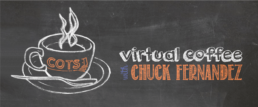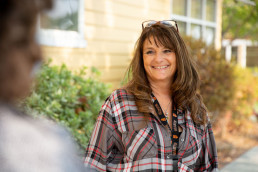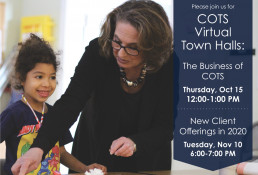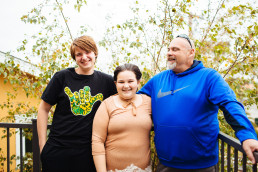Chuck's Virtual Coffee - October 2020
As COTS’ CEO, each month I take a moment to consider what I want our community to know about our organization and our progress in serving Sonoma County’s homeless. I look forward to sharing these thoughts with you in this Virtual Cup of Coffee – my monthly communique about the business and mission moments of COTS (Committee On The Shelterless). In this issue, I focused entirely on why people prefer to live outside instead of getting a bed in a shelter. I hope you enjoy it, and I look forward to your feedback.
Please stay safe,
Chuck
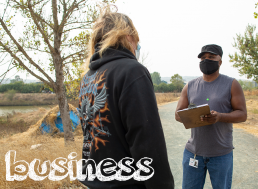
A Bed versus a Tent?
As the weather turns cold and rainy, and we hear about sweeps of homeless encampments, a frequent question we get is, “why don’t people come into a shelter instead of sleeping on the streets?” The answers are many and complicated.
-
- Fear and paranoia – Many suffer from mental health disorders such as schizophrenia, bipolar disorder, PTSD, depression, or anxiety. One consequence is paranoia and fear of large groups, as in a shelter setting with 100 other people. That can set off major panic attacks and fear.
- A fear of the unknown in a shelter – We are creatures of habit. Living on the streets is a known risk – you have some level of control of your day and become “comfortable in uncomfortable situations.” The streets become home and you adapt to the cold or the heat. Conversely, in a shelter, you don’t know what to expect and that fear of the unknown and not having control may be worse than being on the streets.
- Another failed system or institution – Some homeless grew up in “the system” – foster care, residential treatment, jail or prisons, half-way houses. Problems they had with the system can be reinforced and triggering once in another institution (shelter), especially with the rules and structure that come with keeping a shelter safe and orderly. Likely, no one cared for or wanted them while in “the system,” therefore they feel that no one will care for them or want them while in a shelter.
- History of abuse and violence – Many homeless women are victims of physical abuse or sexual violence. It’s little surprise that women do not feel comfortable in a co-ed shelter with male staff.
- Drugs and alcohol – Sadly, drugs and alcohol are prevalent in shelters no matter how much you guard against it. For those wanting to get clean, life in a shelter can be tempting. I’ve seen people come back from treatment looking and feeling great. Days or weeks later in a shelter environment, they are back on drugs or alcohol.
- Not leaving their pets – Dogs provide protection, especially for single women on the streets. Most shelters do not accept pets. Dogs are their best friend, their family, their protector, and so many will sleep outside instead of giving up their pets.
- Crowded conditions – Typical shelters can have 50, 100, or more beds in one large room. With so many people, there are fears of violence and for their own safety, the spread of disease especially during cold and flu season, certainly the lack of privacy, theft of personal items, and again the prevalence of drugs. All of this leads many to prefer the safety of the streets, even if its cold, wet, or hot.
- Feeling closed in – War veterans have commented that the war experiences made them feel unsafe when closed in, so they prefer to live outside.
- So many other reasons – Some have insomnia and don’t like curfew or may want to read late into the night; some don’t want to separate from their husband or wife, as can happen in a shelter where men sleep in separate areas from women; some don’t want to be limited by the “two bags rule” that shelters impose simply because shelters don’t have space to store all of a person’s personal items; some just don’t want to abide by all of the rules of a shelter; and some just prefer the dignity of a tent and being outside with friends than in a warehouse setting with beds, rules, and strangers. They simply want control of their lives and to make their own choices. They prefer to make their own shelter and be autonomous.
Living outside causes significant harm to the environment and is a public health crisis due to the large amounts of trash generated, polluted streams and waterways, fires causes by trying to stay warm or cook meals, unhealthy living, and untreated diseases and illnesses. The 2019 Point in Time Count showed that of the 2,951 total homeless in Sonoma County, 1,957 or 66% of the total counted were unsheltered and living in vehicles, on the street, in tents, or abandoned buildings.
So what can we do to solve this? For starters, we can consider three possible solutions:
-
- Redesign shelters or shelter campuses to have separate living areas (rooms or buildings) for couples, people with animals, those trying to stay clean and sober, women, those that need specialty mental health services, and even an open-style shelter area for Vets. This scattered site approach could each accommodate up to 25 people or fewer so that people feel safe, dignified, can create a new family or friends, and feel like they have some control over their lives. Each area can offer specialized case management, counseling, and services that respect some of their challenges of trauma and adversity in their lives. One sized shelter for all no longer works, and we have to be respectful of each person’s needs and challenges.
- More comprehensive street outreach services – If 66% of the total homeless count are people living outside, then our funding for Street Outreach services must reflect this. This includes funding for law enforcement working together with homeless and other service providers. Part of the Street Outreach Team must include mental health providers and medical providers such as nurses and doctors. Creating relationships and building trust and credibility is one sure way to help those on the streets move into shelter and eventually housing.
- Create an Interagency Street Outreach Network that meets and communicates with each other to coordinate the outreach and care for those on the streets. Some may not want to go into a specific shelter but may agree on another shelter if it can be coordinated. This would be part of a public health approach for the unsheltered.
More homelessness is one consequence of COVID. Doing something different makes urgent sense. It is also good public health.

Until next month,

Chuck Fernandez
October 2020 E-News: COTS Town Hall, Art Sale, and More!
Each month, COTS staff are proud to share news of our programs, our community, and our clients as they work towards permanent housing. Thank you for reading and for supporting our work to end homelessness in Sonoma County!
Thank you for Joining Us for our First Virtual Town Hall!
Our first Virtual Town Hall took place yesterday afternoon, and we were delighted to see everyone and share insights about COTS’ financial model, our strategic plan, and how we adapt to change in a changing world.
Thank you to everyone who joined! If you couldn’t make it but would like to watch a recording of the event, you can do so by visiting the link below, or by clicking here.
If you’d like to join us for our next Virtual Town Hall, New Client Offerings in 2020, on Tues., November 10th 6-7pm, you can do so by visiting the link below. Learn about new programs COTS staff are launching in 2020, including Pathways (a set of offerings to support those pursuing sobriety) and Client Enrichment (including the return of Rent Right, Work Ready, and other opportunities for volunteers). You can register by visiting the link below:
COTS Virtual Town Hall: New Client Offerings in 2020
When: Tuesday, Nov 10, 2020 06:00-7:00 PM
Register in advance for this meeting by clicking here

Art Sale for COTS
This Saturday, Oct. 17, Petaluma artist Deborah Garber will be displaying her pastels, paintings and prints in an exhibition and sale benefiting COTS. The artwork ranges in size from tiny to wall-sized, and will be for sale on a “Pay what you wish” basis, with 100% of the proceeds going directly to COTS. The event takes place at the Out West Garage Roadhouse at 321 2nd St., Petaluma on Saturday, October 17 from 10am-4pm. Masks required.
You can RSVP for the event by clicking here.
The link to purchase/donate for the day of the event is: https://give.cots.org/deborahgarber

Staff Profile: Daisy
Every night is different at the Mary Isaak Center.
“Sometimes nobody’s up,” Daisy Reece, one of our graveyard site coordinators says. “I’ll spend the time cleaning and organizing and just taking care of things.” The lights in the lobby are low, and when she walks through the dorm for to check on everyone, all she hears are snuffles and snores and wheezes.
Other nights are a different story. The hours between 10 p.m. and 6 a.m. can hold enough conflict, triumph, tragedy and farce to fill an entire season of a prestige television.
Whether it’s helping someone calm down after a bout with night terrors, consoling someone who’s just lost a family member, congratulating someone on finding a job, or listening to the plot of someone’s favorite movie, Daisy always has one goal in mind. “I want to build a rapport,” she says. “If I can build a rapport with them, if we can all build a rapport, they’re going to do better at COTS,” she says. “They’re going to be able to move on to the next step.”
Daisy gives people what they need most, says Shelter Manager Robin Phoenix: a kind ear. “There’s something about nighttime that makes people want to talk,” Robin says. “And Daisy is the right person for that. She helps people feel better. And that helps them move forward.”
The best tool in Daisy’s toolkit? Fresh air. “I know it works,” she says. “Going outside gives you a different perspective.”
A two-year COTS veteran, Daisy’s ultimate goal is to teach young children. In fact, in addition to her work at COTS, she’s pursuing a teaching certificate in Childhood Development at the junior college and working at a Montessori pre-school.
How does she do it all?
It helps to be an insomniac. “I have to really burn out to get a good sleep. I need to be this busy,” she says.
Daisy loves her work at COTS “because I’ve always been a helping person. I want to see other people do better.”
In return, “There are so many clients who uplift me,” says Daisy. “I love to hear the way other people think. I love to see every night small changes to where people do a 180 in their lives.” She marvels at the talents and wisdom of our residents. “So many artists,” she says. “So many people who understand computers or who have great stories. I learn so much.”
“But you also end up learning a lot about your own character [doing this work],” she continues. She’s the only one staffing the shelter at night, so “it’s things that other people don’t see.” By putting in the effort to be kind, resourceful, creative and hopeful, she’s learning about her own abilities, setting the stage for her next chapter.
A Sonoma County native, Daisy heard a lot about COTS growing up and while working as a security guard. “People talked about COTS and it made me curious. I wanted to learn more.” With the ambition of running her own pre-school one day, she pays attention to every aspect of COTS’ organization and management style.
We and our residents are lucky to have Daisy on the team.

The COTS Hour-at-Home – Thurs., Dec. 3
You may already know that this year, to prioritize the health and safety of our community, The COTS Hour is going Virtual! Instead of our usual breakfast, we will be airing The COTS Hour-at-Home on Thursday, Dec. 3 on YouTube, Facebook, and our website at cots.org. This will allow us to expand our social reach while maintaining social distance, and we are excited to try a new format in 2020.
Links to the event will be provided closer to the event. But for now, you can help us prepare in one of two ways!
1. Sign up to be a “Table Captain”
While this year, we won’t be renting tables, you can still spread the news of the broadcast – and COTS’ work to end homelessness – with your friends, coworkers, and family. Host a viewing party and share the recording with your network for maximum impact. Table Captains will receive a special swag bag prior to this year’s event, and other brand new benefits in 2020! Email Jamieson Bunn, Director of Development, at [email protected] or call (707-765-6530 ext. 100 to learn more or read our Table Captain 101 here.
2. Sponsor the event
Event sponsors make our work to end homelessness possible and set an example of philanthropy at a time when it’s needed most. And this year, we’re offering even broader visibility to our community than ever before with a virtual event with no guest limit and three broadcast times throughout the day on Dec. 3! Event sponsors receive the same benefits as Table Captains plus publicity for your business through COTS’ website, social media, and the event itself. Learn more by emailing Jamieson Bunn, Director of Development, at [email protected] or call (707-765-6530 ext. 100 – and check out our Sponsorship Benefits package here.
Thank you for your investment in our neighbors experiencing homelessness! Together, we can make sure everyone has the opportunity to find and keep permanent housing in Sonoma County.
Feeling uncertain about watching a virtual event? We made this helpful How-To Guide to show you how!
Chuck's Virtual Coffee - September 2020
As COTS’ CEO, each month I take a moment to consider what I want our community to know about our organization and our progress in serving Sonoma County’s homeless. I look forward to sharing these thoughts with you in this Virtual Cup of Coffee – my monthly communique about the business and mission moments of COTS (Committee On The Shelterless). In the Business portion, I will share the nuts and bolts of what we do to serve the homeless – our successes and our challenges. In the Mission Moment, I will share stories about our clients and our wonderful staff who make it all happen. I hope you enjoy it, and I look forward to your feedback.
Please stay safe,
Chuck
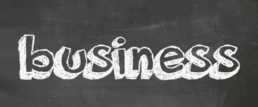
The Urgent Need for More Mental Health Services
For those that exercise or pride themselves on their health, the emphasis is typically physical – running, walking, low cholesterol and blood pressure, and the absence of disease. When talking about health and fitness, we usually don’t talk about mental health, which can be just as debilitating or more than a serious physical ailment. Many of us have family, friends, or know of someone that suffers from mental illness. It could be Schizophrenia, Bipolar Disorder, Dual Diagnosis, Depression, Anxiety Disorder, PTSD, or more.
The National Alliance on Mental Illness (NAMI) posts some staggering statistics on mental illness:
- 1 in 5 U.S. adults experience mental illness.
- 17% of youth (age 6-17) experience a mental health disorder.
- American adults living with mental illness die an average of 25 years sooner than others, largely due to a treatable condition.
- 37% of students suffering from mental illness drop out of high school.
- More than 90% of children who die from suicide suffer from a mental health condition.
- Serious mental illness costs the U.S. about $193.2 billion in lost earnings per year.
- People with depression have a 40% higher risk of developing cardiovascular and metabolic disease than the general population.
When I look at mental illness and the population that COTS serves – those experiencing homelessness – the numbers are also staggering:
- 35% suffer from psychiatric/emotional conditions.
- 75% have experienced some form of trauma.
- 38% suffer from drug/alcohol abuse.
- 34% have a history of domestic violence
We know that people with mental illness are at greater risk of homelessness. We also know that the stress of being homeless intensifies mental illness and can exacerbate anxiety, fear, depression, drug use, and more.
Now, as if the fires, national political turmoil, and recession are not enough, we have COVID-19 and its consequences on our mental health. Working from home, job loss, social isolation, grief for the loss of a loved one all add to fear and uncertainty. And even when we get a vaccine, that fear, anxiety, depression will not go away. In fact, decades of underinvestment in mental health and healthcare in general, especially for the poor, were exposed by the consequences of COVID.
This is not doom and gloom. This is our reality and we need more financial investments in our social support services if we are to address growing mental illness in our community.
This Virtual Coffee is dedicated to mental health and what we can do to begin to invest in our community. In this election season, Measure O is on the ballot to ask for tax dollars to invest in more mental health services. I am not here to tell you how to vote. That is not my job. I am here to share what we see every day at COTS with our residents at our adult and family shelter, those we help on the streets, in their cars and RVs, and in encampments who suffer from severe mental health illness – children, adults, veterans, seniors – all experiencing homelessness. We need more financial investments to address mental health.
The monies from Measure O will go toward emergency psychiatric care; mobile support teams that accompany law enforcement on crises intervention calls (we use this at COTS); mental health services at children’s shelters; residential treatment facilities; suicide prevention; mental health services for children, veterans, and seniors; expansion of substance use disorder services; behavioral health services for individuals who are homeless; and so much more. The residents in our shelters and on the streets will benefit greatly from these investments.
As a concerned citizen wanting assurance that these monies will be spent as intended, there will be an Independent Citizens Oversight Committee to provide transparency and fiscal accountability. That works for me and Measure O works for me. In the interest of those experiencing homelessness, I support Measure O.

Until next month,

Chuck Fernandez
Business Profile: Bank of Marin

“Give to the world the best that you have and the best will come back to you.”
- “Life’s Mirror” by Madeline S. Bridges (Bank of Marin Founder Bill Murray’s favorite quote)
“If we do good, then everybody does better.”
That was Bank of Marin founder Bill Murray’s philosophy. And what did “doing good” mean for Mr. Murray? Turning a healthy profit, providing great services and giving back to his community.
The bank’s annual performance and ever-growing number of customers attest to his first two requirements. And we at COTS can vouch that 30 years after its founding, Bank of Marin still lives to give back to the community.
You can’t visit COTS without seeing reminders of Bank of Marin’s commitment to doing good. We drive a van donated by Bank of Marin, our office cubicles came courtesy of Bank of Marin, our kitchen and gardens have benefited from Bank of Marin employees’ volunteer labor. The Bank has been a generous and steady investor in our work and encourages their employees to do likewise; they match employee giving and provide paid time off for volunteering.
And we’re not the only good cause to be grateful to operate in Bank of Marin’s orbit. In Sonoma County alone, the bank supports over 50 nonprofits. Across the Bay Area, where Bank of Marin has 24 offices, they support more than 300 nonprofits.
The bank focuses its giving on housing and human services, education, the arts, seniors, and economic development.
And the bank tells us that during the pandemic they are doing even more, donating a third of the fees earned by submitting more than 1800 Paycheck Protection Program applications for local businesses to provide funds to local schools in the seven counties in which it operates. The bank’s one stipulation? The money must be used to ensure that low income children get the resources they need to keep up with school while distance learning.
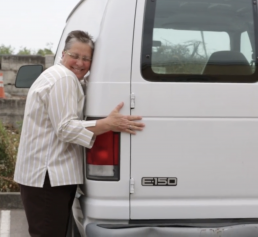
Shelter Services Manager Robin Phoenix hugging the van Bank of Marin donated COTS
“We feel our obligation to be a community partner is greater than ever now, when so many are struggling,” says Russell A. Colombo, the bank’s current and longest-serving President and CEO. “The health of our nonprofits and schools is crucial to our shared recovery.”
The bank is “doing fine,” Russ says. “And many other businesses have made adjustments and are doing well. Those of us who aren’t struggling need to do things to help. We encourage other businesses to join us.”
Elece Hempel, the Executive Director of Petaluma People Services, says that Bank of Marin is “a partner in everything we do at PPSC.” That includes PPSC leadership: Claudia Levindofske, a former Branch Manager, serves on Elece’s board.
From tellers to operations managers and commercial lenders, Bank of Marin’s staff members influence many giving decisions. “We want our employees to support the causes that they believe in passionately,” Russ says. That passion gets shared, and soon, an entire branch is eager to help. That’s how Bank of Marin helped COTS with a fundraiser at Lagunitas a few years ago: one employee enlisted another. That person enlisted another, and soon there was a mighty group that threw a bash so lovely that our supporters outdid themselves.
That’s also how Bank of Marin became a big supporter of the Marin Symphony. Renee Rymer, a Market Manager, inspired a love of classical music and the symphony among her colleagues. Bank leadership took note and formed a partnership with the symphony that still endures. Renee retired from the bank but continues to serve on the symphony’s board.
According to David Short, Bank of Marin’s Regional Manager for Sonoma County, it’s especially important for team members to serve on nonprofit boards, and employees currently serve on over 60 boards. David says, “It’s through that leadership that we get to know about all the good work that’s being done by so many inspiring organizations.”
Thank you, Bank of Marin!
Want to read more stories about our business sponsors? Visit our Business Gives Back homepage by clicking here!
Share this story with your friends and family:
Chuck's Virtual Coffee - August 2020
As COTS’ CEO, each month I take a moment to consider what I want our community to know about our organization and our progress in serving Sonoma County’s homeless. I look forward to sharing these thoughts with you in this Virtual Cup of Coffee – my monthly communique about the business and mission moments of COTS (Committee On The Shelterless). In the Business portion, I will share the nuts and bolts of what we do to serve the homeless – our successes and our challenges. In the Mission Moment, I will share stories about our clients and our wonderful staff who make it all happen. I hope you enjoy it, and I look forward to your feedback.
Please stay safe,
Chuck

The Ability to “LeaderShift”
This has been a nonstop challenging year. The pandemic and all of its devastating consequences on a personal, economic, and social level. The credible and courageous protests around systemic racism. National politics and an election year filled with anxiety and anticipation. And now, the fires. As a business, how does COTS survive and thrive through all this change and uncertainty?
In his book, Leadershift – the 11 Essential Changes Every Leader Must Embrace, John Maxwell says, “leaders today need to move faster, stay ahead, be able to see more than others, and able to see before others see. The more nimble, adaptable, and flexible we are, the more quickly we can move and change.” He says “adaptability does not mean conformity. Conformity means being average and refusing to stand out or capitalize on one’s uniqueness. Adaptability is being able to sense the shift in the wind direction and adjust to take advantage of that wind.” He also says, “leaders need to be comfortable with uncertainty and make shifts continually…and deal with uncertainty without losing focus. They must also allow for creativity, they must plan, and they must look for options and opportunities.”
The need to Leadershift is happening at COTS. We are updating our Strategic Plan (SP). It was created in 2018. And yes, only two years later, it already feels outdated. We have new staff, a better understanding of Housing First, more professionalism, more freedom to create and bring our best and passionate selves to work, and a profound belief that we will make a difference in the lives of those experiencing homelessness. We also want to make sure our updated SP reflects our desire to be a more diverse organization and that our culture, behavior, how we make decisions, and our goals reflect our Diversity, Equity, and Inclusion Statement. Change of course always start with us first – how we individually think, behave, and treat Diversity, Equity, and Inclusion differently.
At COTS, we are also accepting reality, sometimes the harsh reality, during these complex times – no sugarcoating, especially when we communicate with our staff. In social services, because we can be more heart than head, we want to protect staff or the agency from dangers or uncomfortable realities. We need to bring reality into the conversation sooner than later and be upfront with the difficult part of our journey that we plan to take others on. If we don’t, we just set everyone up for failure and disappointment.
We also have to rely on our solid foundational values of integrity, respect, and accountability to ourselves, each other, and to those experiencing homelessness as we continue to change and evolve. I would add character and moral authority – how we live our lives and treat the sheltered and unsheltered – with authenticity, humility, and love. There is no compromise here regardless of how difficult the change.
And one more thing – besides looking for options and opportunities during these uncertain times, we as leaders should always be preparing for opportunities – strengthening our programs to better serve those experiencing homelessness, ensure positive impact in the community and social return on investment for our funders, and build strong administrative functions that support our programs and services. As the legendary basketball coach John Wooden said, “when opportunity comes, it’s too late to prepare.” COTS is preparing.
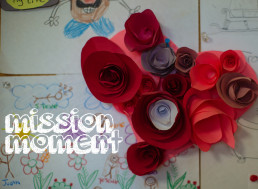
A Passionate Calling
Some of us have a job…a good job. It pays the bills and supports our family. We do the work well when we are there. When the workday is done so are we until the next day. We likely don’t take work home with us. Some of us have a career. It’s something we choose, excel at, love, and it can be measured by success such as money, a nice house, more freedom with our schedule, a nice car.
Then there are those that have a calling. A calling is about helping others – in non-profits, fire or law enforcement, law or medicine, public service, the hospitality and food service industry, and so much more. It is something that you have chosen or maybe has chosen you, that never leaves you even when the day is done…you take it home with you, is something you feel you must do, and is your purpose and why you exist. Your calling gives you energy, purpose, meaning, hope, and optimism. It inspires creativity and attracts others with positivity.
I see this calling every day at COTS. I know I often use the Mission Moment sections of my Virtual Coffee on our exceptional staff at COTS. But if you see what I see every day, you would too. Every Saturday, one of our shelter staff makes a big breakfast for our shelter residents – what you would make for your family when you have time on the weekends – omelets, pancakes, waffles, breads, fresh fruit, coffee, cereal. It’s John’s way to celebrate each person at our shelter. It’s important for our residents to have some sense of normalcy.
I see our case managers Julia and Christina teaching residents about sobriety and are so excited when residents show up, are engaged, and make progress. Of course, residents are enticed with ice cream and root beer floats when they arrive. Staff celebrate when a resident gets housed and then they help them set up their apartments – with linen, dishes, food, and whatever furniture we have. Shelter staff make sure residents take their medications, get the rest and medical care they so often need – and with all the love, attention, and care as if that resident was their own family member.
Of course, because our residents suffer from trauma, mental, physical, and emotional challenges, providing this love and care is often not easy. Residents’ behavior can be erratic, disappointing, threatening – they shout, swear, refuse to follow rules or their case management plans, or do not show up for meetings on time or at all. This is just part of what we do and what we expect. Likely, many of us know this having dealt with it on a personal level with a family member or friend. Giving up is not an option for our staff. It’s not who they are. A resident may feel hopeless and give up on themselves, but the staff won’t give up on them. Often, staff are the only hope for our residents. For some of our staff, they know the struggle, pain, and confusion because they have been in our resident’s shoes before. Thus, their commitment, dedication… their calling.
Philosopher Howard Thurman said, “don’t ask what the world needs. Ask what makes you come alive and go do it. Because what the world needs is people who have come alive.” I see our staff at COTS come alive everyday.

Until next month,

Chuck Fernandez
Business Profile: Bay Alarm

Every year, just after Mother’s Day, alarms go off for Bay Alarm.
Buy it’s not anything to worry about. Savvy bargain hunters and antique dealers just know they’d better get up early for Bay Alarm’s annual garage sale benefitting COTS. People come so early that Branch Manager John Reynolds and a few of his crew have taken to camping out in the parking lot the night before so that they can be ready for a swarm of early birds.
Teamwork like that and service to the community are the part of the reason Bay Alarm boasts one of the lowest employee turnover rates in the county, says Office Manager and Sales Coordinator Erica Suisala. “One in every five employees has been here over 15 years,” she says. “We like our jobs.”
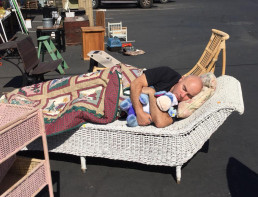
Petaluma’s Bay Alarm is one of only 17 branches of a family-owned company founded in the post-war years. Bay Alarm is now the largest privately owned security company in the nation. The Petaluma branch employs about 50 people and serves a mix of businesses and households.
The garage sale is all hands-on deck project for several months, Erica says. The team donates items themselves and picks up truckloads from their colleagues at other branches. We at COTS also put out the word to our supporters, and Bay Alarm graciously accepts everything from dolls and china to armoires and living room sets. In advance of the sale, every nook and cranny of the office gives way to furniture, appliances and knickknacks.
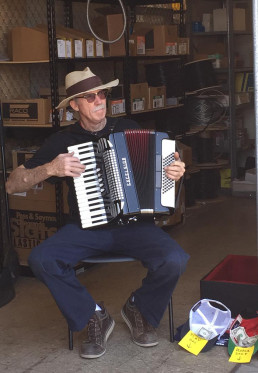
On the day of the sale, the team augments its proceeds by selling hotdogs and beverages. One of Bay Alarm’s Field Supervisors Daniel brings out his accordion, too. “People can pay him to play or not to play,” says Erica. “It’s their choice.” She declines to say how the voting skews.
COTS is one of Bay Alarm’s favorite causes because “How could you not want to help homeless people?” Erica asks. “They’re right here where we live.”
The branch also participated in the Suicide Prevention Walk last year, and, once COVID has less of a hold on our lives, they plan on taking a vote among the employees to choose an additional cause or two.
COVID put their plans for a garage sale on hold this year, but they’re eager to bring it back next year. We are so grateful for Bay Alarm’s support and advocacy.
Thank you, Bay Alarm!
Want to read more stories about our business sponsors? Visit our Business Gives Back homepage by clicking here!
Share this story with your friends and family:
Business Profile: Summit State Bank

Volunteers from Summit State Bank helping out nonprofit Farm to Pantry
Community banking means you know your customers and community.
“Our tellers greet customers who walks in by name,” says Roni Brown, Senior Vice President and Director of Marketing for Summit State Bank. “We all live in this community and are connected. We know what’s going on in our backyard. We know what’s important.”
We at COTS know that we’re lucky to have Summit State Bank on our side. The bank has been a generous supporter for many years. And a curious one—about us and about all the causes it supports.
“I do my research, so I know our donations are staying in our community,” Roni says. She’s responsible for vetting applications from nonprofits, and she pores over financial statements and program results. She also asks around. Having grown up in Sonoma County, she knows a lot of people to ask! The bank’s charter is “to do for the greater good of the community.” For Roni, that means “I need to make sure we’re giving to agencies that are effective and that are aligned with our mission.”
The North Bay Business Journal named the bank one of the top 20 corporate philanthropists in the North Bay.
Since the fires, basic needs like food, housing and security are high on Summit State Bank’s list, Roni says. That means support for agencies like COTS, the Redwood Empire Food Bank, Verity and the St. Vincent de Paul Society. Now, during the pandemic, their focus is renewed. “Especially at times like these when so many people are out of work, it has to be about the basics.” Roni says. “This is hitting home for everybody.”
Most of the bank’s account holders are businesses, both the for-profit and non-profit kinds. For non-profit account holders, Summit State Bank has a special partnership, Nonprofit Partner Program, through which it pays above-market interest rates on account balances and provides donations and volunteer support. That volunteer support can include board membership, an invaluable donation of expertise and affiliation.
Christine Castillo, Executive Director of Verity, which works to end all forms of violence in Sonoma County, and focuses primarily on ending sexual assault and helping its victims heal, says, “Summit State Bank has been such an amazing partner and support to Verity. They understand the needs of non-profit organizations and are caring and supportive of our work. They are quick to provide us detailed response and support with not only our banking, but in checking in with us to see how we are all doing during this time of COVID19. It is truly a pleasure to work with Summit and a gift as well!”
The bank recently gained new business accounts because of its success with Paycheck Protection Program loans for its customers. “It was all-hands on deck,” Roni says. “Our focus was on helping our customers keep their doors open, keep their employees on the payroll.” With five branches and fewer than 100 employees in total, Summit State Bank closed over 500 loans in just three weeks.
“It was a constantly evolving process. There were a lot of touch points with customers, a lot of back and forth as we got new information,” Roni says. “The relationship we have with our customers was key to getting it done.”
“We’re never going to be the biggest player,” Roni says. “But that’s our strength, too. We’re accessible. One of the things that I’m most proud of is that we’re nimble and connected to the community.”
Thank you, Summit State Bank!
Want to read more stories about our business sponsors? Visit our Business Gives Back homepage by clicking here!
Share this story with your friends and family:
August 2020 E-News: Recovery at COTS: from COVID to Connection
Each month, COTS staff are proud to share news of our programs, our community, and our clients as they work towards permanent housing. Thank you for reading and for supporting our work to end homelessness in Sonoma County!
Stopping COVID in its Tracks
With surges in COVID-19 happening across the country, it was only a matter of time: this August, a client in our Kids First Family Shelter was diagnosed with COVID-19. But the good news is, COTS staff acted fast! All families at KFFS were immediately evacuated to private hotel rooms with the help of Sonoma County officials, who also arranged for testing – and thankfully, everyone else’s results came back negative within a few days! In the meantime, KFFS has been professionally deep-cleaned. We are looking forward to welcoming our families back to COTS and helping them continue their progress towards permanent housing soon.
However, since it looks like we’ll all be living with the threat of COVID for a few months longer, COTS is implementing additional – and permanent – safety protocols that will keep clients and staff better-protected in the months ahead.
First, we get to thank the team at Rebuilding Together Petaluma, who installed a new permanent hand-washing station in our kitchen at the Mary Isaak Center. This replaces a temporary station set up at the beginning of the pandemic and will allow kitchen staff and volunteers to more easily follow safety protocols at every meal.
Thanks to a grant from the state, we are also able to add touchless faucets and a new HVAC system with UV light filters to our arsenal. HVAC systems using UV Light have been shown to be effective in eliminating even the most stubborn airborne bacteria and viruses, and while studies on its effectiveness in preventing COVID-19 are ongoing, we are hopeful that the new system will keep all of our staff and clients healthier long-term.
Together, we at COTS will continue to do everything we can to keep our community healthy and housed.

New Bunks, Better MIC
This summer, with support from the state, COTS was able to replace the old bunks in our Mary Isaak Center dorm with brand new models!
This was a wonderful change for staff and clients alike. The old bunks had a wider footprint making the pathways between beds harder to navigate. They also had no ladders to the top bunk! This was a huge barrier to residents with mobility issues – and was still a climb for even our sprightlier clients. Historically, many clients were limited to bottom bunks due to lack of ladders and railings for the top bunks. This meant that clients spent a longer time on the waitlist to receive shelter services. With the new bunks we are able to serve clients more efficiently and safely.
We are thrilled to have a more accessible bed and a more efficient space for every resident.
Special thanks to the hard-working volunteers from the Occidental Arts and Ecology Center who helped us construct the bunks!
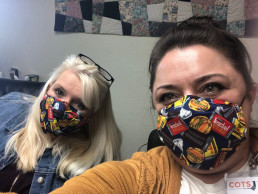
Pictured: Christina Madden, left, and Julia Dodge, right, masked up at the Mary Isaak Center
Launching new Recovery Pathways
In our June Virtual Coffee with CEO Chuck Fernandez, we announced the launch of a new program at COTS called Pathways that provides additional choices to our clients who want help recovering from substance abuse. One way we do that is through recovery groups that meet a range of needs.
SMART Recovery is one option for clients, led by Julia Dodge, Lead Recuperative Care Coordinator. SMART stands for Self-Management and Recovery Training. The SMART approach differs from traditional AA programs in that uses a secular and evidence-based program focused on learning coping skills to help people live more productive and connected lives.
Recovery Maintenance is another group aimed at supporting clients throughout their recovery journeys. Led by Christina Madden, Shelter Case Manager & Recovery Specialist, it helps clients not just by preventing relapse but by providing clients with connection, support, and opportunities for self-care.
The two programs are complementary – clients are able to visit both groups to test the waters to see if recovery is right for them. Some clients even choose to attend both groups long-term to receive additional support.
Neither group is limited to participants at the Mary Isaak Center. Clients across our housing programs, including our parents at the Kids First Family Shelter, are welcome to join at any time. Because as Julia and Christina say, “The opposite of addiction isn’t sobriety, it’s connection.” With their range of experience in the field, they understand that addiction is a coping mechanism for life’s hardships – and science shows that the more connected an individual is with friends, family, and community, the less likely they are to rely on substances to make it through.
“I really believe that Pathways can solve our homeless problem in Sonoma County,” says Christina. With your support, we think she’s right.

AmazonSmile
With the fall school year and the upcoming holiday season on the horizon, don’t forget to set COTS as your charity of preference on AmazonSmile! Just search “Committee on the Shelterless” in the AmazonSmile Charity Lists and start giving back with every purchase! COTS has received more than $1,100 in donations from AmazonSmile, and it’s a great way to give back without adding to your monthly budget. Just remember to shop through the AmazonSmile link at smile.amazon.com.
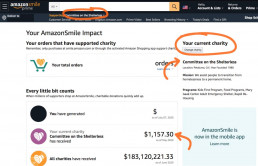
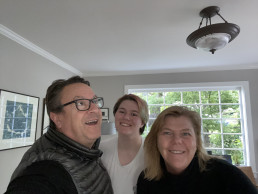
Donor Spotlight: the Hathaways
For Ellen and Andrew Hathaway, supporting COTS is a family affair. When they first moved to Petaluma, Ellen started making deliveries for our food box program. Their toddler, Mars, would be in the back seat as Ellen drove from home to home. When Ellen had other engagements, Andrew would take her place on the route.
“We got to see the same people every week. It got to be about people we knew,” Ellen says. She went on to volunteer in our Rent Right class, where she worked one-on-one with our clients as they completed housing applications and budgets. She still sees some of the people she helped—they’re at their jobs or walking around their neighborhoods, doing well.
Ellen runs an executive search firm and has served many nonprofits as a consultant, board member, donor and volunteer. Andrew is a Sales Engineer for Adobe. They loving living within walking distance to downtown and being involved in lots of community activities.
“Especially now, with the pandemic, and all the problems that seem so big, I keep coming back to how fortunate we are in Petaluma to have COTS. It helps the unhoused. But it helps the community as a whole. Nobody wants to see people living on the streets. COTS lifts us all up.”
Ellen and Andrew make monthly donations which Adobe matches dollar for dollar.
“What I’ve learned over the years is that I may not be able to control the bigger world, but I can do things to make my own community better. Everyone deserves dignity. That’s the baseline, and we can do that in our community,” Ellen says.
Thank you, Hathaway family!
Business Profile: Friedman’s Home Improvement

For Friedman’s Home Improvement, both shopping local AND giving local is a way of life. Nonprofits, teams, schools, and organizations for seniors can all count on Friedman’s for support and advocacy.
At COTS, Friedman’s has been a mainstay of our programs for families with children since our very earliest days. Not only does Friedman’s fund COTS generously, the company provides us with free and discounted materials and lots of skilled volunteer labor. If you want a volunteer who knows how to paint, repair and build, recruit from your local family-owned home improvement store!
We also appreciate Friedman’s visits to check out how we’re doing. They are truly interested in how we help homeless kids and parents regain housing. We love the fact that they regularly donate advertisements on KZST for us. And we could never put on our Thanksgiving feasts without Friedman’s annual avalanche of turkeys. Next time you’re behind a green Friedman’s truck on the freeway, imagine it full of turkeys and you’ll get an idea of how much we depend on them every November.
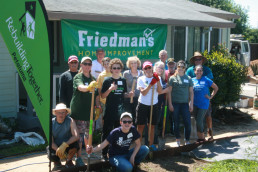
We’re not alone in our gratitude. Jane Hamilton, the Executive Director of Rebuilding Together, has counted on Friedman’s for over a decade. “They are a solid community partner,”’ she says. So far in 2020 alone, when several of her projects had to be postponed, Friedman’s funded a host of Rebuilding Together projects, including home repairs and accessibility alterations for an 82-year-old widow, a veteran with physical challenges, and a man who is paraplegic. “Friedman’s is a true Hometown Hero, always there to give back to the community” Jane says. And Jane is one of many nonprofit leaders eager to sing Friedman’s praises.
We at COTS are proud of our 32-year history, but Friedman’s has us beat by more than 40 years. The first store was founded by Joe and Benny Friedman, two brothers who came home to Petaluma from World War II. Benny’s son Bill Friedman took the helm in the 1980s. Barry Friedman, Bill’s son and Benny’s grandson, became CEO in 2013.
The company has grown to include four North Bay Area retail stores and extensive facilities and services for contractors. Much of its expansion has taken place in recent years with the reopening of the Petaluma location in 2014 and opening of the Distribution Yard in 2018, which helped the company increase its offerings to the region’s contractors and support the vast building efforts needed here over the next decade.

Friedman’s has played a role in the North Bay’s recovery from fires and floods—and, now, a pandemic.
As an essential business, all of the Friedman’s Home Improvement stores remain open during the pandemic. Like all essential businesses, they’ve had to adopt new safety practices and incur new costs. “The pandemic has made it abundantly clear what is important: the people in our lives, our families and basic human needs. At Friedman’s our mission is to deliver the human side of home improvement,” Barry says.
When asked why his family company gives so widely and so generously, he says simply, “Friedman’s believes in supporting the community that has supported us for 74 years.”
And community involvement is more important than ever, Barry says. “Supporting each other, our team, our customers and our community: we are people helping people.” The pandemic offers a unique opportunity, Barry says, “to truly understand what it means to be a community, celebrating our differences and finding the common threads that unite us all. We are in this together.”
Thank you, Friedman’s Home Improvement!
Want to read more stories about our business sponsors? Visit our Business Gives Back homepage by clicking here!
Share this story with your friends and family:
Join us for a socially-distanced BBQ fundraiser!

Looking for a great way to support COTS and have some socially-distanced fun this Friday night? Well, thanks to W. Bradley Electric and Ray’s Catering, you can enjoy some delicious BBQ AND help raise money for COTS! From 4-7pm this Friday, July 31st, Ray’s is serving up three delicious dinner options for pick-up in the Lucchesi Center Parking Lot. Just place your order at rays-catering.com by Thursday, July 30th at 8:30pm, and pick up your meal between 4 and 7pm the next day! COTS will get 15% of all sales, and you’ll get a tasty meal, and Friday night taken care of. This is available for PICK-UP ONLY, so if you plan on ordering please do so in advance!
This fundraiser wouldn’t be possible without the help of our amazing business partner, W. Bradley Electric. WBE suggested the fundraiser to us, and is paying for its employees’ meals. Wow! Thank you to W. Bradley Electric and Ray’s Catering for their partnership in this event!
Order your meal today!
